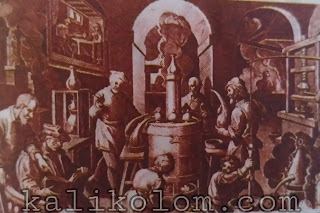Origin of Modern Science Expanding Horizons
Introduction
Renaissance
Evidence of the origin of modern science and technology is found in ancient Rome and ancient India. One of the foundations of modern science and technology is the correct scientific theories that Cicero, Hikitas, Aristarchus and others in the West and Aryabhata, Brahmagupta and Brahmihi in India spoke of. Later, however, the overall progress and influence of modern science revolved around Europe. Constantinople, the heart of Greek and Roman epistemology, fell to Turkish Ottoman Empire in 1453, and became the capital of the Ottoman Turkish Empire. After the fall of Constantinople, most of the Greek and Roman scholars and intellectuals moved to Italy with their ancient manuscripts and continued their scientific studies there. As a result, in the fifteenth century, Italy made great strides in various fields such as art, literature, science, etc., known as the ‘Renaissance’. The wave of renaissance gradually spread from Italy to all over Europe. The effects of the Renaissance led to the emergence of modern science, unprecedented advances in technology in various fields, revolution in the printing industry, and the sailors of various European countries became addicted to discovering new lands through naval expeditions.
Origin of Modern Science
The foundation of modern science was laid in ancient times in different countries of the world.
1. In India: In the Gupta period, Aryabhata spoke of the position and rotation of planets with the help of mathematical formulas. His Aryabhatiya contains the first accurate scientific discussion of ancient India. In this book he discusses arithmetic, algebra, geometry, trigonometry etc. Brahmihir and Brahmagupta also excelled in science in this age. In the ninth-tenth centuries AD, Mahavira, Sridhar, Manjul, Aryabhata II, etc. showed their erudition in mathematics in India.
2. In Europe: The influence of the Renaissance in Europe in the fifteenth century greatly changed the concept of ancient science. Throughout the sixteenth and seventeenth centuries, extensive and unimaginable advances were made in various branches of science. Due to the influence of scientific progress, great progress can be noticed in various fields like agriculture, industrial production, military system, printing system etc. Historians have called this advancement of science the ‘Scientific Revolution’.
3. Practical and philosophical aspects
Two major aspects of the progress of science in this age can be noticed: [i] the practical aspects of science and [ii] the philosophical aspects of science. The practical side of science was inextricably linked with people’s daily lives. Applied science excelled in various fields of agriculture, industry, education, etc. in Europe. Advances in modern chemistry popularized applied science. On the other hand, in the discussion of science-philosophy, the structure of the universe, the relationship of the universe with other astronomical objects, etc., gained importance and new scientific truths were established in this regard. The advancement of chemistry in the practical field of science and the concept of the heliocentric universe in the field of science-philosophy were one of the most important aspects of the origin of modern science.
From chemistry to chemistry
Although the practice of chemistry is quite ancient in practical terms, in ancient times this practice was never based on sound reasoning and science. In ancient times, there was no place for rational chemistry in the Greek and Roman eras. At this time Aristotle spoke of the four elements in the formation of the universe ক্ষ Kshiti, Op, Tej, Marut. Over the next several decades, the practice of knowledge flourished in Europe, relying on this misconception of Aristotle. Despite these errors in the knowledge of chemistry, these ideas were prevalent throughout Europe until the Middle Ages.
Operation
The practice of chemistry in Europe, from ancient times to the Middle Ages, without logic and modern science, is known as ‘alchemy’ or ‘alchemy’.
1. Origin of the word The Greek word Khemia is thought to have originated from the ancient Egyptian word ‘Khem’. The term was coined by the Arabs after the Arab conquest of Egypt in the 7th century AD. The English word Alchemy is derived from the Arabic word ‘Al-Kimiya’, which in Bengali is operasayan. Although in ancient Greece, Egypt, China, etc., the practice of aparasayana, but in Europe, this practice came from Arabia.
2. Subjects associated with alchemy The alchemy involved the practice of astrology, witchcraft, omnipresence, mysticism, meaningless attempts to make gold and other precious metals from ordinary metals, and so on.
3. Astrology
In astrology, different metals were thought to be associated with different planets
4. Witchcraft
Preachers of sorcery say that nature is controlled by miraculous powers and used for the benefit of humankind.
5. Follow omniscience
The existence of life in all objects of nature was conceived by the omniscient doctrine.
6. Mysticism
Fans of mysticism thought that there were different kinds of occult powers in nature. Human beings will benefit if human beings can control these forces.
7. Attempts to make precious metals
Alchemists were engaged in the study of the conversion of lead or any common metal into a precious metal, especially gold, by chemical process. They were looking for a side stone that would turn ordinary metal into gold in an instant.
8. Notable chemist
Some of the notable chemists in Europe were Mohammed Umail Al Tamini, Benjamin Musafia, Hermes Trismejistus, Cornelius Agrippa, Paracelsus, Albert Magnus and others.
Origin of Aprasayan
The beginnings of alchemy began in ancient Egypt. The ancient Egyptians believed that people have a life after death. For this reason, their efforts to discover a method of preserving corpses or making mummies led to the development of their chemical knowledge. This is how the practice of this subject first started in Egypt.
Proliferation of alchemy
Alexander the Great conquered Egypt in 332 BC. Gradually, Greek philosophers came in contact with the worldview of the Egyptians. They were influenced by the Egyptians’ view of the formation of different objects with the help of these four elements ক্ষ land (earth), op (water), energy (fire) and marut (air). The Greeks began to practice this, and it is in this way that the practice of apostasy began in Greece. After the Arab conquest of Egypt in the 7th century AD, the practice of alchemy spread from Egypt to Arabia. This practice was brought to Spain by the Arabs in the eighth century AD. From there it later spread throughout Europe. It is pertinent to note that the practice of alchemy began separately in ancient China and India.
The basis of operation
The practice of opacity was, for the most part, limited to theory. It had no real basis. In the fifteenth century, the Reformers associated with the Reformation movement opposed this sorcery. But the popularity of these among the common people has not diminished. Chemists used a variety of chemicals to treat many diseases. But they could not explain the real cause of the disease. So people thought it was magic. It was only by reforming this magic that the introduction of modern science was possible later. This is why many people call magic ‘pre-science’ or ‘proto science’.
End of chemistry
Until the fifteenth century, the widespread practice of chemistry in Europe severely hampered the practice of actual chemistry. But from the seventeenth century onwards the failure of chemistry became apparent to man. Modern chemist Robert Boyle, Hooke, Mayo, etc., expose the flaws and errors of modern chemistry. The universe, formed by the imaginary beads of Aristotle and Plato, gradually crumbled. The theory of the three elements propagated by Paracelsus is also proved wrong.
The importance of operation
1. Introduction to precision chemistry
There was no scientific basis for the magic of operas. There was also no science in the use of the armor provided by Paracelsus to get rid of the plague. But when his followers began to practice chemistry for the purpose of using various elements of nature through magic, a path must be paved towards modern precision chemistry. Modern chemistry originated from the reform of chemistry. That is why many call alchemy the Laboratory of Modern Science.
2. New discoveries
Alchemists were the first to discover gunpowder, metallurgy and other techniques. The chemist Paracelsus discovered a metal element called zinc.
3. Concepts about the structure of matter
The seventeenth-century concept of particle theory, that is, the idea of the formation of matter by tiny particles, dispels all previous misconceptions. Boyle, a new-age scientist, defined the basic elements. Although the physicist Isaac Newton did not go very far in chemistry, his picture of the structure of the atom is very similar to that of modern chemistry.
The beginning of modern chemistry
The development of various branches of modern chemistry began after the end of non-chemistry. This has led to advances in metallurgy, element discovery, air component, chemical industry, medicine, etc.
Metallurgy
Metal melting technology was invented in Europe around 1340 AD. The most practical application of chemistry from the fifteenth century can be seen in metallurgy. Advances in metallurgy led to the formation of chemical processes such as mercury-hybridization, oxidation, deoxidation, distillation, etc. Techniques for the use of copper and zinc ore were invented in Germany. George Agricola (1494-1555 AD) published a book on metallurgy called De re metallica. In it he discusses the different types of furnaces suitable for metal smelting. The technique of combining mercury with silver and smelting gold was discovered chemically.
Discovery of new elements
A notable feature of modern science was the establishment of proper modern chemistry as a separate branch of science. From the fifteenth century onwards, new substances began to be discovered. During this time new metals like phosphorus, bismuth, platinum etc. were discovered. Humphrey Davy discovered the elements sodium, potassium and calcium in 1806 and divided all the basic elements into metals and non-metals. In modern chemistry, the properties, properties, etc. of new substances become the subject of knowledge. John Dalton established his modern theory of atomic structure. He is known as the father of modern atomism. Gradually positive and negative charges of atoms, radicals, organic compounds etc. are formed.
Practice chemistry related to air
1. Combustion and respiration require air
The discovery of the vacuum pump by Otto von Geric (1802-6 AD), which was able to create an airless state, gave rise to a modern chemical formula almost a century later. There are also indications that the need for air is essential for both combustion and respiration.
2. Discovery of oxygen
Mayo proved in 164 AD that heating metal increases its weight. Boyle, Hook, and Mayo claim that there is an element in the air that is essential for combustion and respiration. Mayo named this material ‘Nitro Aerial Spirit’. In 184, Priestley discovered oxygen gas.
3. Gas collection method
The chemist Stephen Hales showed how to collect gas on water and how to measure the volume of gas in the early eighteenth century. Priestley and Cavendish further developed this method and discovered the method of collecting gas on mercury.
4. Evidence of the need for oxygen in combustion
Lavoisier shows that oxygen gas is required for combustion. He further showed that water is produced by combining hydrogen gas with oxygen.
5. Discovery of chlorine
Shell discovered chlorine in 184, and Bertol in 184 showed that chlorine has a bleaching ability.
6. The concept of molecules
Combining the ideas of John Dalton, Bargelius, and Gay Lusak, Avogadro proposed the idea of molecules, stating that all gases of equal volume have the same number of molecules at the same pressure and temperature.
Boyle’s chemistry
In the seventeenth century, the British chemist Robert Boyle (1827-1891 AD) signed various fundamental studies in chemistry. He published his dissertation on the elemental particles of matter in The Sceptical Chemist in 181. In ancient times, Aristotle’s theory of the explanation of all natural phenomena by the four elements মা earth, air, fire, and water proved to be incorrect. Boyle said that nature can be explained by the motion and organization of elementary particles. He proved that the volume of a gas of a certain mass at a given temperature varies disproportionately with the pressure exerted on it.
Chemical industry
1. Industry and trade
The advancement of modern technology in the sixteenth century led to the advancement of industrial production and trade in Europe.
2. Chemical industry
The demand for a few chemicals required with industrial production increased considerably during this time. These are sora, alum, iron sulphate, sulfuric acid, soda etc. The chemical industry emerged to meet the demand for these products. Production of these substances began on a commercial basis. German scientist Perkin’s discovery of the artificial pigment magenta in 1858 led to the advancement of German industry.
3. Progress
The problems and experiences that can be seen in the work of the chemical industry have led to great advances in modern chemistry.
Chemistry in medicine
From the time of the practice of aparasayana it became a medical aid. Later, chemistry was widely used in modern pharmacology.
1. The medicine is ready
Various herbal medicines are being prepared using chemical ingredients.
2. Treatment of syphilis
The sailors who went to America with Columbus brought a contagious sexually transmitted disease called syphilis to Europe. The treatment of this disease is started using mercury and antimony metals in chemical process.
3. Skin color
Female miners began using arsenic to enhance their skin color.
4. Combustion power of oxygen
Lavoisier proves that the living body behaves like fire, it burns food and releases combustion energy. The use of chemicals in the treatment of various diseases began during this time. The use of chemical techniques has made great strides in medicine.
Other chemical practices
In addition to the medical field, the application of chemical methods in various other fields began at this time.
1. The technique of molecular division of compounds using chemical methods was discovered. Joseph Black invented the chemical method of separating the elements of carbon dioxide gas in 1854.
2. The French scientist made a list of the basic substances of Lavoisier and spoke of the law of mass permanence.
3. Francis Bacon also improved this science by doing various researches in chemistry.











1 thought on “Expanding Horizons | Origin of Modern Science”